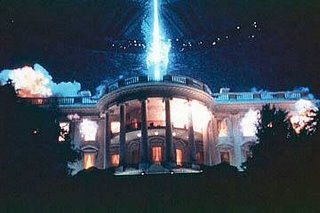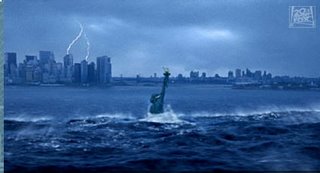The disaster movie is a genre that has been around for decades, killing a variety of usually cliched characters by fire, earthquake, asteroid, volcano, tsunami, and many other ferocities of nature.
Disaster movies have been around since the 1930's, with San Francisco depicting the city's notorious earthquake, but it wasn't until the 1950's and '60's that disaster movies took on more epic proportions thanks the science-fiction craze with When Worlds Collide and Them! (giant ants) amongst others.
 However, the classic disaster movies were spawned in the 1970's with The Poseidon Adventure (1972); ocean liner capsized by tsunami, The Towering Inferno (1974); world's tallest building catches fire, and Earthquake; massive earthquake strikes Los Angeles. Studios also began using all-star casts in such films, particularly after the success of Airport.
However, the classic disaster movies were spawned in the 1970's with The Poseidon Adventure (1972); ocean liner capsized by tsunami, The Towering Inferno (1974); world's tallest building catches fire, and Earthquake; massive earthquake strikes Los Angeles. Studios also began using all-star casts in such films, particularly after the success of Airport.
By the mid-70's, the genre was beginning to burn itself out (no pun intended). The obvious disasters had all been used up, so studios began producing sillier movies with weaker disasters and cheaper actors (such as The Swarm's killer bees)
 The 1980's saw the disaster movie retreat into obscurity after its '70's hey-day, with only the 1983 TV Movie The Day After providing any value with its depiction of nuclear war. Disaster movies, and in particular the airplane-set Zero Hour, was even ridiculed by the hilarious Airplane! (1980), that perhaps put a few nails in the coffin…
The 1980's saw the disaster movie retreat into obscurity after its '70's hey-day, with only the 1983 TV Movie The Day After providing any value with its depiction of nuclear war. Disaster movies, and in particular the airplane-set Zero Hour, was even ridiculed by the hilarious Airplane! (1980), that perhaps put a few nails in the coffin…
 But the final nail was never hammered into place and, thanks to advances in special-effects post-Jurassic Park (itself a disaster movie at heart), the 1990's saw a massive resurgence of the genre – spearheaded by 1996's Independence Day (alien attack).
But the final nail was never hammered into place and, thanks to advances in special-effects post-Jurassic Park (itself a disaster movie at heart), the 1990's saw a massive resurgence of the genre – spearheaded by 1996's Independence Day (alien attack).
The massive box-office of Independence Day saw studios clamouring for more technically impressive disasters to dramatize, such as Daylight (collapsed tunnel drama with Sylvester Stallone). Parodies even became an accepted variant of the genre with Mars Attacks! (1997).
The frenzy for CGI-assisted disasters meant movies with similar premises also battled each other at the box-office – as with Dante's Peak versus Volcano and Deep Impact versus Armageddon (comet/asteroid impacts).
 Then, in 1997, the disaster movie achieved its crowning glory with the release of James Cameron's Titanic, which won 11 Academy Awards and became the biggest-grossing movie in history ($1.8 billion so far). It was only fitting that the world's most famous disaster became the disaster genre's most famous movie.
Then, in 1997, the disaster movie achieved its crowning glory with the release of James Cameron's Titanic, which won 11 Academy Awards and became the biggest-grossing movie in history ($1.8 billion so far). It was only fitting that the world's most famous disaster became the disaster genre's most famous movie.
After the millennium, the disaster movie beat another hasty reteat following the events of 11 September 2001, when the world watched a real-life disaster unfold on the news. How could a movie possibly compete with reality, or even exist to entertain people anymore? Two years later, The Core dipped a toe into the water again with its tale of a subterranean disaster. Interestingly, given its post-9/11 release, the movie was more about stopping a global disaster, rather than experiencing one…
 But, in 2004, the genre returned in force with The Day After Tomorrow, an environmental disaster movie that upped the ante by containing numerous global disasters and didn't flinch from destroying New York landmarks again. In 2006, Poseidon, based on the classic 1972 movie that started the modern craze for cinematic catastrophe, is about to be released… so the genre is most definitely not dead. But with a remake of When Worlds Collide also on the cards... is it now entering a "recycling phase"?
But, in 2004, the genre returned in force with The Day After Tomorrow, an environmental disaster movie that upped the ante by containing numerous global disasters and didn't flinch from destroying New York landmarks again. In 2006, Poseidon, based on the classic 1972 movie that started the modern craze for cinematic catastrophe, is about to be released… so the genre is most definitely not dead. But with a remake of When Worlds Collide also on the cards... is it now entering a "recycling phase"?
Also of interest this year is the fact reality will collide with fiction in the disaster movie genre (for the first time) when two projects about the events of 11 September 2001 are released – United 93 and World Trade Center.
